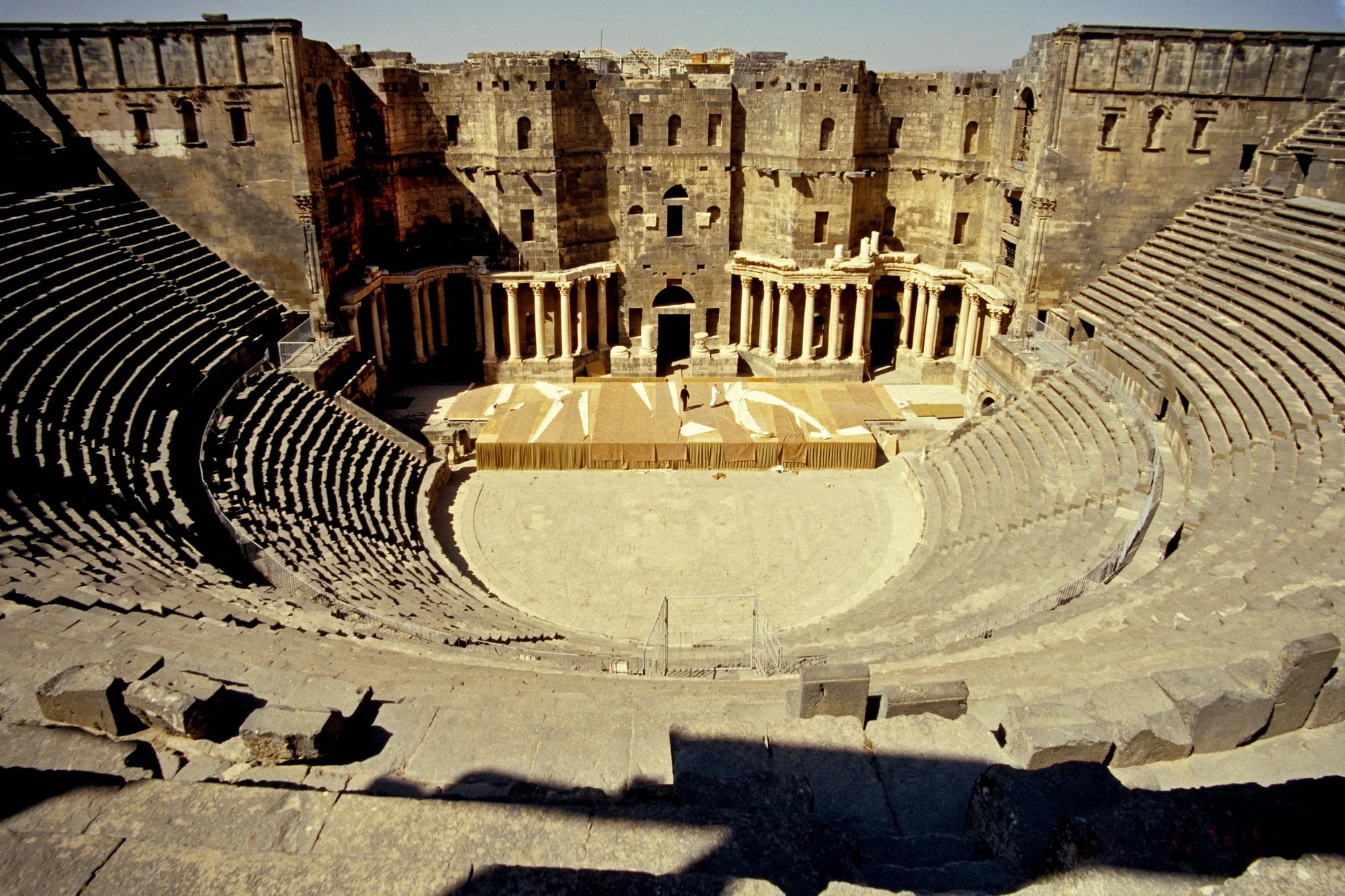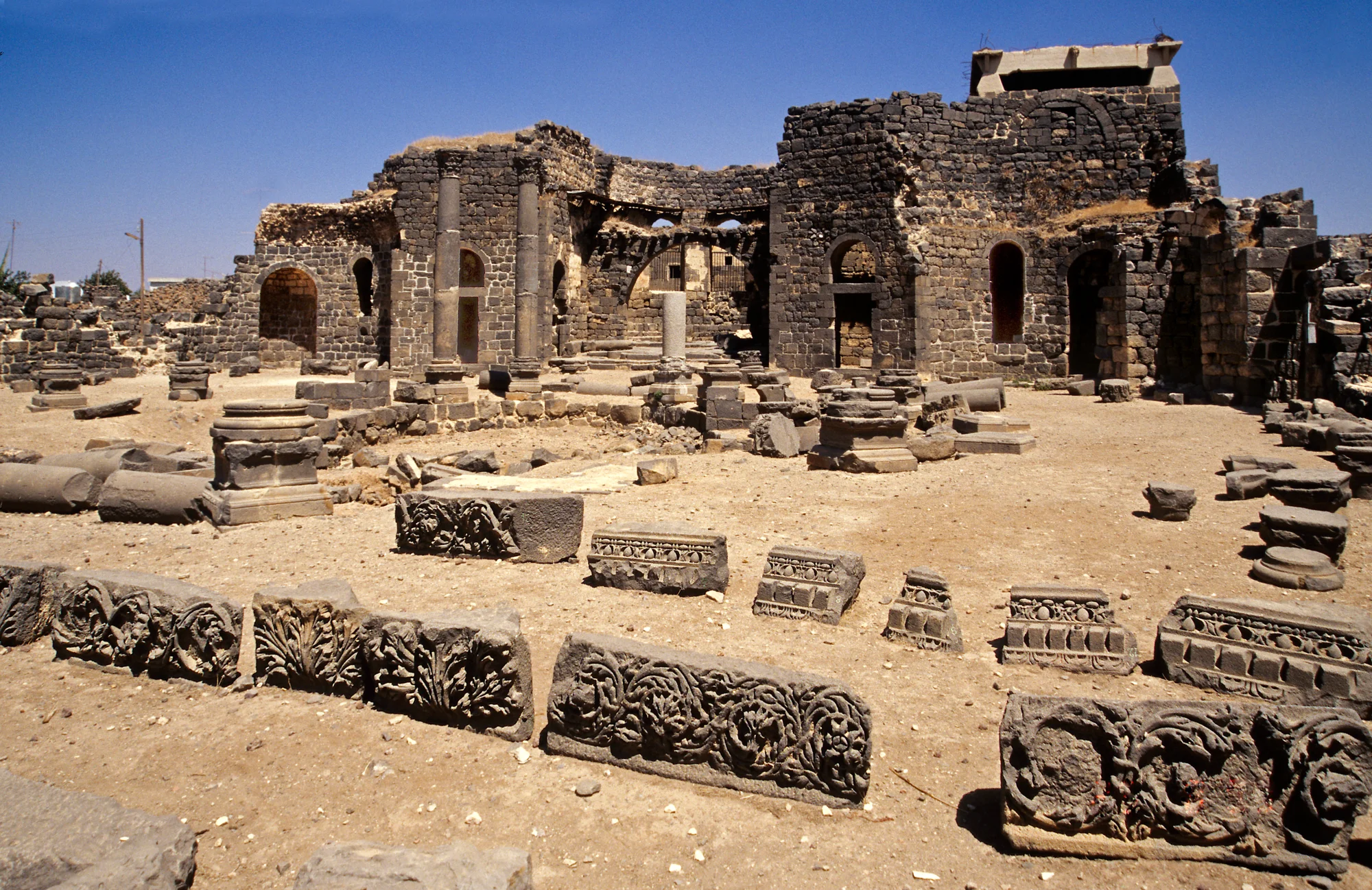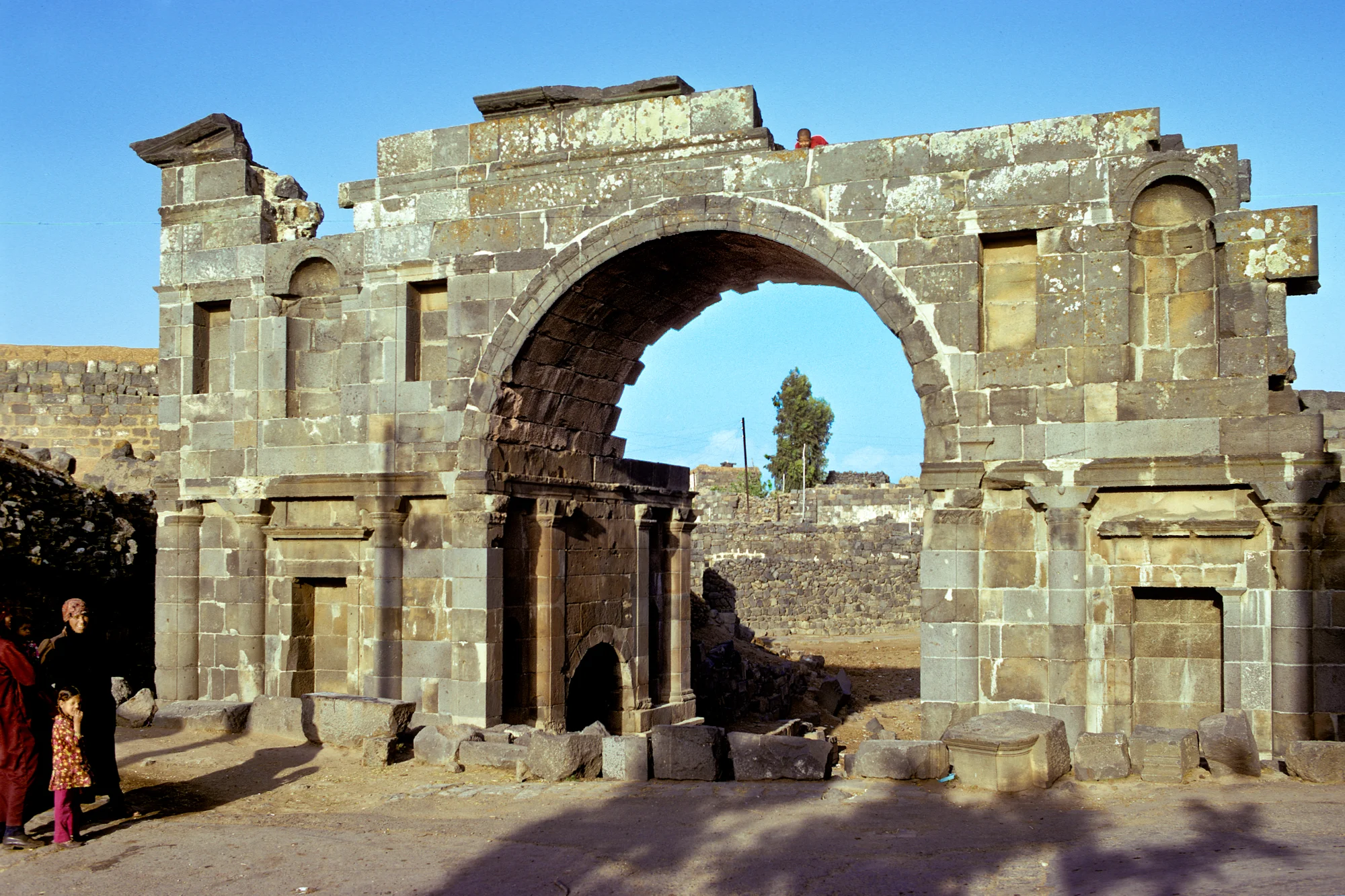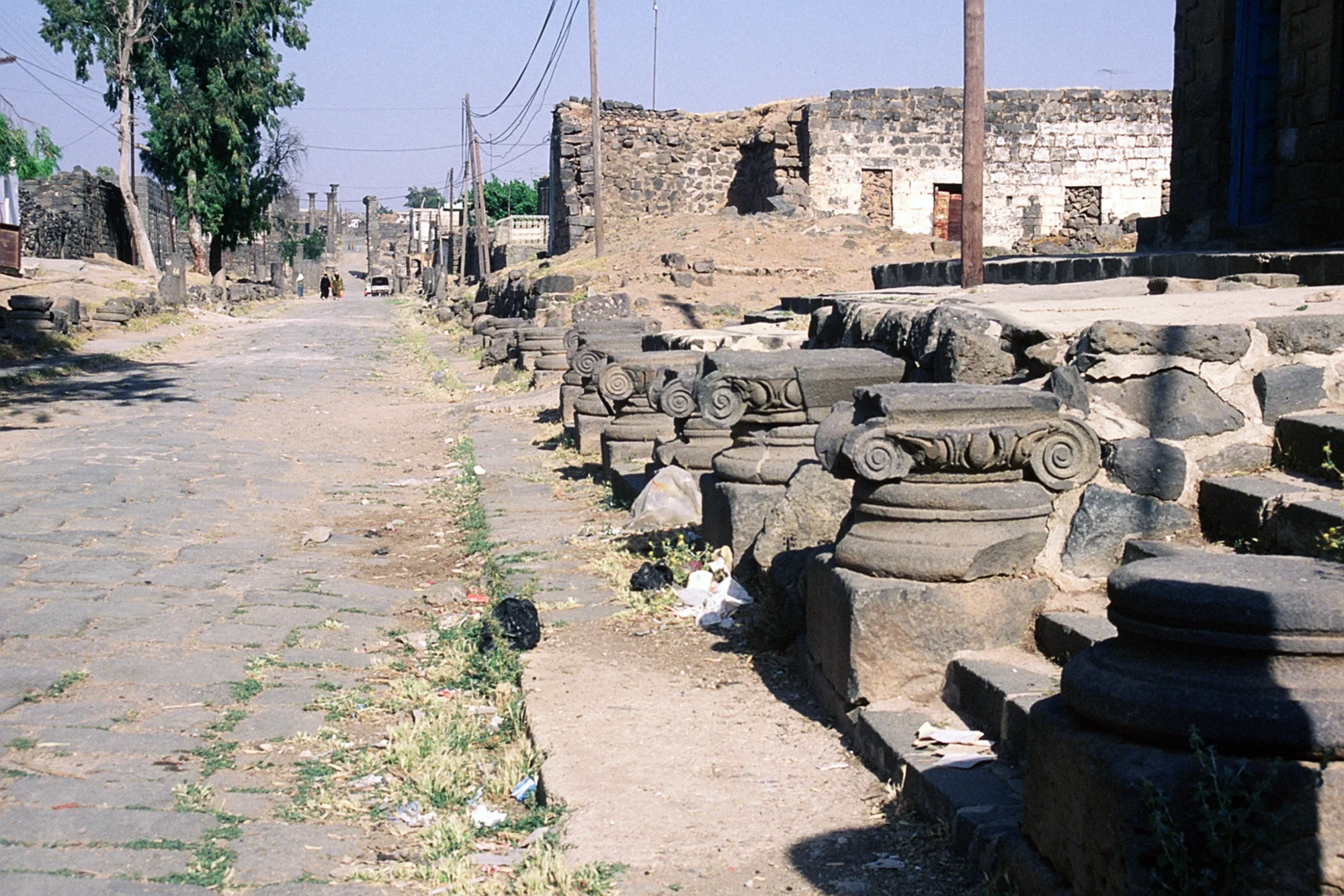by Gabriele Hamzé-Conrad
The shadows became longer. He crossed the large roof terrace with slow steps, almost sleepwalking. He was barefoot, enjoying the coolness under his hot soles, as he strolled over to the stone parapet of the citadel, leaning against it to look over the battlements and flat roofs of the ruined city of black basalt. The city of ruins, where people still live and go about their daily business as if a wind had carried them through time. That is what gave Busra such a strange charm. The ancient world flowing across into the now, the now slid over into the ancient world.
How many nights could he have spent in this barren tower room? Reflecting, reading, writing, avoiding his narrow, hard bed, as the sleep shuns him. He thought of his friend, the outstanding scientist and passionate person who had died far too early. ** The most formative memories of their friendship were bound to this very place, which challenged them both in their science… That’s why he had to come back, here. … He looked down at the colonnade, at the black cobblestone of antiquity, glowing in the light of the setting sun. … Only here could he find his friend once more, in this great ruined place from which they both drew, which inspired their imagination. …


He chatted with the children who crossed his path, philandered and cheerfully made his jokes with them. They stormed together through the narrow, shady streets of Busra, jumped boldly over the stone blocks at the edge of the path, chased each other around the pillars. And they laughed and screamed and romped wildly. Until they finally sank down exhausted between the scattered stone fragments and stumps of columns. It began to get dark. The children ran home, in all directions. To the West Gate, to the Nabataean Gate, to the citadel, to the basilica, to the cistern, to the mosque, to the Hammam Manjak, behind the baths, to the small museum, to the madresse. From here and there one could hear their mothers’ cries, long stretched out sounds of their names.




The crickets chirped shrilly, the hot summer air buzzed from their wings. Wind came up, blew over from the plains. Daniel turned to the Columned Street, because he loved to walk over the Roman cobblestone, which inspired his imagination, inspired him like few things in his life as researcher. …
He directed his step towards the Great Mosque, towards the Hammam Manjak, the Islamic bathing complex, once excavated by his dead friend. There he hoped to find comfort, knowing that he was close to him at this place like no other. His proximity and the memory of the years of common work would give him strength, would fill his waiting. He reached the bath, flooded by the moonlight, white silver in its brightness.
The Great Mosque and the Bath cast long shadows. The city was silent, no one could be seen, no sound could be heard. …. To preserve the peace, this divine silence and the holiness of the hour, he carefully took his steps. He approached the hammam. Each step consciously set, gently, quietly. He touched the wall, groped reverently over the black blocks with the hand of the knower, stepped thoughtfully along the wall shimmering dull in the moonlight, until he reached the arched, window-like, wrought iron-clad deep opening to the side of the street. He paused for a brief moment, pondering, thinking of his friend … And saw in front of him the beginnings of this excavation once in November, which was followed by many Novembers. When the cold winds turned from the plain and swept through the ruins. November days when they froze, struggled in hard work. But the urge for knowledge and the hope to be part of it soon filled these days with serenity. … He looked at the monument for a long time and he knew that he and his friend were rewarded. … He moved, while his right hand illuminated by the moonlight, gently glided along the wall towards its opening. From there he could look into the interior … of the early medieval bath, whose missing dome allowed a view to the sky. He reached the wrought iron grille and stepped in front of it and, slightly stooping, looked into the room. He held his breath. On the stone benches that surround the hammam, two girls sat, in absolute equality, facing each other in conversation. The bright moonlight drew their contours, the lines of their faces, as if with a pencil. They whispered, the sounds were inaudible. Their movements were of the grace and suppleness of the light summer wind… Their floor-length robes and headdresses glowed in the reflection of the soft, almost daylight moonlight. Shimmered in red and black.


Fata Morgana? Sarab at midnight? One was dressed in black, the other in crimson. They sat there, murmuring, whispering, pausing in word again and again, their even, absolutely identical faces leaning towards each other, almost touching. They sat so deeply serious. Daniel was startled in joyful astonishment, and immediately withdrew from the wrought-iron opening. He felt caught, as if made into a vulgar confidant of a secret, he was ashamed of his indiscretion. He leaned with his back against the wall and paused. He thought. Wasn’t the hammam always closed? Even during the day, to ward off the noisy, boisterous crowd of children from Busra? Unlocked, it had become a popular hiding place for them, even a battlefield in the struggle between rival gangs. And hadn’t the hammam only just been saved from decay and destruction? For a long time now, the key could only be obtained from the guard, and the bath could only be opened in his presence. …
*This text has been shortened considerably and is taken from the book “Archaeology of the Soul” by Gabriele Hamzé-Conrad, published in 2018 by Autumnus-Verlag, Berlin.
** Michael Meinecke (1941-1995) directed the excavation and restoration campaigns of the early Islamic bath Hammam Manjak by the Department of Antiquities in Busra and the German Archaeological Institute Damascus between 1981 and 1993. This work resulted in the restoration of the ruins of the Hammam, whose original construction was completed in 1372/773, in accordance with the requirements of monument preservation.
Featured image: The old city of Busra, a UNESCO World Heritage Site © Museum für Islamische Kunst, Staatliche Museen zu Berlin – Stiftung Preußischer Kulturbesitz, Foto: Michael Meinecke (CC-BY-NC-SA)
Published by Gabriele Conrad-Hamzé: Gabriele Conrad-Hamzé worked at the German Archaeological Institute in Damascus and lived for years within sight of the ruins of Busra. With her Syrian husband and local supporters, she first established a centre for environmental education, then the refugee childcare “Let’s play, let’s learn” with a focus on literacy in Suwayda.
